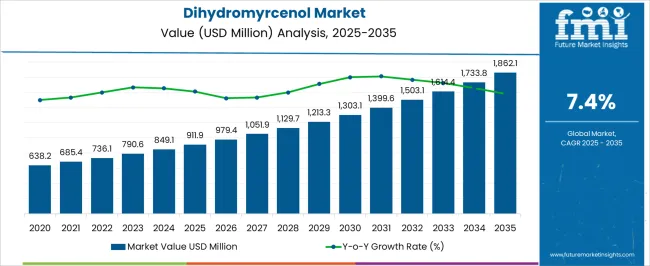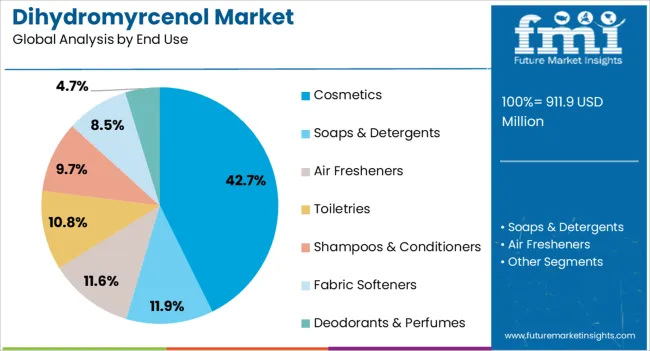The Dihydromyrcenol Market is estimated to be valued at USD 911.9 million in 2025 and is projected to reach USD 1862.1 million by 2035, registering a compound annual growth rate (CAGR) of 7.4% over the forecast period.

| Metric | Value |
|---|---|
| Dihydromyrcenol Market Estimated Value in (2025 E) | USD 911.9 million |
| Dihydromyrcenol Market Forecast Value in (2035 F) | USD 1862.1 million |
| Forecast CAGR (2025 to 2035) | 7.4% |
The Dihydromyrcenol market is experiencing steady growth, driven by its widespread application as a fragrance ingredient in personal care and household products. The current market scenario reflects strong demand from the cosmetics industry, fueled by consumer preference for clean, fresh, and long-lasting scents in daily use products. Advancements in fragrance formulation technology and increasing adoption of synthetic aroma compounds have supported broader inclusion of Dihydromyrcenol across product lines.
The future outlook is shaped by the rising disposable income, growing awareness of personal grooming, and expansion of global cosmetic and personal care markets. Environmental and regulatory compliance trends have also influenced the production of high-purity grades to meet industry standards, ensuring consistent quality and safety.
Manufacturers are increasingly focusing on high-purity Dihydromyrcenol to enhance fragrance stability and intensity, which has further contributed to the market expansion The overall growth is expected to be sustained by innovations in fragrance blends, increasing demand for premium personal care products, and the integration of synthetic aroma compounds in commercial formulations, positioning Dihydromyrcenol as a key ingredient in the fragrance industry.
The dihydromyrcenol market is segmented by grade type, end use, and geographic regions. By grade type, dihydromyrcenol market is divided into ≥99% and <99%. In terms of end use, dihydromyrcenol market is classified into Cosmetics, Soaps & Detergents, Air Fresheners, Toiletries, Shampoos & Conditioners, Fabric Softeners, and Deodorants & Perfumes. Regionally, the dihydromyrcenol industry is classified into North America, Latin America, Western Europe, Eastern Europe, Balkan & Baltic Countries, Russia & Belarus, Central Asia, East Asia, South Asia & Pacific, and the Middle East & Africa.

The ≥99% grade type segment is projected to hold 58.40% of the Dihydromyrcenol market revenue share in 2025, making it the leading grade type. This dominance is being driven by the high purity requirement for fragrance formulation, where consistent scent quality and stability are critical. High-purity Dihydromyrcenol ensures predictable olfactory performance, allowing formulators to develop fragrances with precise intensity and long-lasting profiles.
The growth of this segment has been reinforced by increasing consumer demand for premium personal care products and high-quality fragrances in both established and emerging markets. The ability to integrate ≥99% grade Dihydromyrcenol into a wide range of products, including perfumes, body sprays, and hair care formulations, without affecting stability, has further strengthened adoption.
Manufacturers are leveraging the purity of this grade to offer enhanced fragrance experiences, while minimizing variations and maintaining compliance with industry standards As the personal care and fragrance industries continue to expand globally, the high-purity grade is expected to remain the preferred choice, supporting sustained market leadership.

The cosmetics end-use segment is expected to account for 42.70% of the Dihydromyrcenol market revenue share in 2025, establishing it as the largest end-use sector. This leadership is being attributed to the extensive use of Dihydromyrcenol in perfumes, body care, hair care, and skincare products, where it enhances fragrance appeal and product differentiation.
The growth of the cosmetics segment has been reinforced by rising consumer spending on personal grooming, heightened interest in fragrance customization, and demand for long-lasting aromatic experiences. The adoption of Dihydromyrcenol in cosmetic formulations is favored because of its high stability, compatibility with other aroma compounds, and ability to produce consistent olfactory effects.
Increasing urbanization and the influence of lifestyle trends have further accelerated the use of fragrance ingredients in daily-use cosmetic products As global cosmetics markets expand and consumer preference shifts towards high-quality and premium fragrance experiences, Dihydromyrcenol is expected to maintain a dominant role in the sector, with continued opportunities for innovation and product diversification within the cosmetics industry.
Dihydromyrcenol is an organic chemical compound belonging to the family of acyclic terpenoidal alcohols. Dihydromyrcenol is a colorless liquid that provides a citrus or floral fragrance. Dihydromyrcenol is insoluble in water but soluble in alcohol and paraffin oil. Dihydromyrcenol is prepared from myrhenol and dihydromyrcene, which are derivatives of turpentine.
Dihydromyrcenol is widely used in the fragrance composition of soaps, detergents, citrus/lime like perfumes and fresheners. It is also used in the production of shampoos, conditioners and toiletries. Dihydromyrcenol has successfully replaced various types of citrus oils which are allergenic in nature. Dihydromyrcenol is also used as an intermediate in the production of compounds, such as myrcetol or tetrahydromyrcenol.
Over the years, the cosmetic industry has shown steady growth. However, in the coming years, it is expected that the cosmetic industry will witness significant growth. Growing population, increasing urbanization and people's inclination towards personal care have led to increase in the consumption of the cosmetics & personal care products. Similarly, increase in disposable income has also surged the sales of cosmetics & personal care products. Growing inclination of people towards the use of cosmetics and beauty care products due to the growing influence and penetration of social media is an important factor pushing the growth of the cosmetics and personal care products demand.
Also, the growing focus being put on the advertisement of beauty care products will further drive the cosmetics and personal care products market. Similarly, introduction of new cosmetic and beauty care products will have a positive impact on the Dihydromyrcenol market. Changing lifestyle and increased standard of living have increased the penetration of laundry care and home care products, which is also leading to increasing demand for dihydromyrcenol.
However, growing demand for cosmetics & personal care products containing natural ingredients will be a major restraining factor in the Dihydromyrcenol market.
Growing population and increased urbanization have led to the growth of the cosmetics and personal care industry growth in Asia Pacific region. Also, increased inclination towards beauty care & personal care products and increasing disposable income have surged the spending on cosmetic products in countries, such China & India.
Thus, due to the above discussed factors, the Asia Pacific region is expected to witness lucrative growth in the dihydromyrcenol market. In Latin America, rising urbanization and increased spending on cosmetic and personal care products have made this region a potential market region for dihydromyrcenol. The dominance of the cosmetic industry in the Middle East region and rise in urbanization in regions of Africa have increased the consumption of cosmetic and personal care products in these regions, owing to which the Middle East and Africa will be a promising region in the Dihydromyrcenol market.
North America and Europe are matured market regions in terms of the Dihydromyrcenol market. In North America and Europe, increasing demand for beauty care & personal care products containing natural ingredients is being witnessed. In countries, such as the UK, almost 50% of cosmetic and personal care products consumers are demanding products containing natural ingredients. Thus, increasing demand for products containing natural ingredient will slow down the growth of the dihydromyrcenol market in North America and Europe.
Examples of some of the market participants operating in the global Dihydromyrcenol market are: De Monchy Aromatics, Suru Chemicals, Symrise, Merck KGaA, Neeru Enterprises, Chemtex USA, Inc., Anthea Aromatics, Phoenix Aromas & Essential Oils LLC and Privi Organics Ltd. among others.
The Dihydromyrcenol market research report presents a comprehensive assessment of the Dihydromyrcenol market and contains thoughtful insights, facts, historical data and statistically supported and industry-validated market data. It also contains projections using a suitable set of assumptions and methodologies. The Dihydromyrcenol market research report provides analysis and information according to Dihydromyrcenol market segments such as geographies, application and industry.
The Dihydromyrcenol Market report is a compilation of first-hand information, qualitative and quantitative assessment by industry analysts, inputs from industry experts and industry participants across the value chain. The report provides in-depth analysis of parent market trends, macro-economic indicators and governing factors along with Dihydromyrcenol market attractiveness as per segments. The report also maps the qualitative impact of various market factors on Dihydromyrcenolmarket segments and geographies.

| Country | CAGR |
|---|---|
| China | 10.0% |
| India | 9.3% |
| Germany | 8.5% |
| France | 7.8% |
| UK | 7.0% |
| USA | 6.3% |
| Brazil | 5.6% |
The Dihydromyrcenol Market is expected to register a CAGR of 7.4% during the forecast period, exhibiting varied country level momentum. China leads with the highest CAGR of 10.0%, followed by India at 9.3%. Developed markets such as Germany, France, and the UK continue to expand steadily, while the USA is likely to grow at consistent rates. Brazil posts the lowest CAGR at 5.6%, yet still underscores a broadly positive trajectory for the global Dihydromyrcenol Market. In 2024, Germany held a dominant revenue in the Western Europe market and is expected to grow with a CAGR of 8.5%. The USA Dihydromyrcenol Market is estimated to be valued at USD 330.4 million in 2025 and is anticipated to reach a valuation of USD 608.1 million by 2035. Sales are projected to rise at a CAGR of 6.3% over the forecast period between 2025 and 2035. While Japan and South Korea markets are estimated to be valued at USD 43.4 million and USD 23.6 million respectively in 2025.
| Item | Value |
|---|---|
| Quantitative Units | USD 911.9 Million |
| Grade Type | ≥99% and <99% |
| End Use | Cosmetics, Soaps & Detergents, Air Fresheners, Toiletries, Shampoos & Conditioners, Fabric Softeners, and Deodorants & Perfumes |
| Regions Covered | North America, Europe, Asia-Pacific, Latin America, Middle East & Africa |
| Country Covered | United States, Canada, Germany, France, United Kingdom, China, Japan, India, Brazil, South Africa |
| Key Companies Profiled | Givaudan SA, BASF SE, International Flavors & Fragrances Inc., Symrise AG, Takasago International Corporation, MANE SA, Firmenich International SA, and Robertet SA |
| Additional Attributes |
The global dihydromyrcenol market is estimated to be valued at USD 911.9 million in 2025.
The market size for the dihydromyrcenol market is projected to reach USD 1,862.1 million by 2035.
The dihydromyrcenol market is expected to grow at a 7.4% CAGR between 2025 and 2035.
The key product types in dihydromyrcenol market are ≥99% and <99%.
In terms of end use, cosmetics segment to command 42.7% share in the dihydromyrcenol market in 2025.






Full Research Suite comprises of:
Market outlook & trends analysis
Interviews & case studies
Strategic recommendations
Vendor profiles & capabilities analysis
5-year forecasts
8 regions and 60+ country-level data splits
Market segment data splits
12 months of continuous data updates
DELIVERED AS:
PDF EXCEL ONLINE

Thank you!
You will receive an email from our Business Development Manager. Please be sure to check your SPAM/JUNK folder too.
Chat With
MaRIA